Finance 12 Assignment: Future Value, Investments and Annuities
VerifiedAdded on 2020/04/01
|14
|1515
|117
Homework Assignment
AI Summary
This finance assignment delves into various aspects of financial calculations and investment strategies. The solution begins with future value calculations, exploring different compounding frequencies, including annual, monthly, and continuous compounding. It then addresses annuity calculations, determining the required annual deposits to reach a financial goal, both as an ordinary annuity and as a lump sum. The assignment further analyzes term deposits, comparing the returns of different interest rates and compounding periods, along with after-tax interest calculations. Finally, it examines retirement planning, calculating the required annual percentage rate and time needed to accumulate a specific amount, considering different deposit scenarios and compounding methods. The assignment uses formulas and calculations to provide a comprehensive understanding of financial concepts. The references are also mentioned at the end of the assignment.
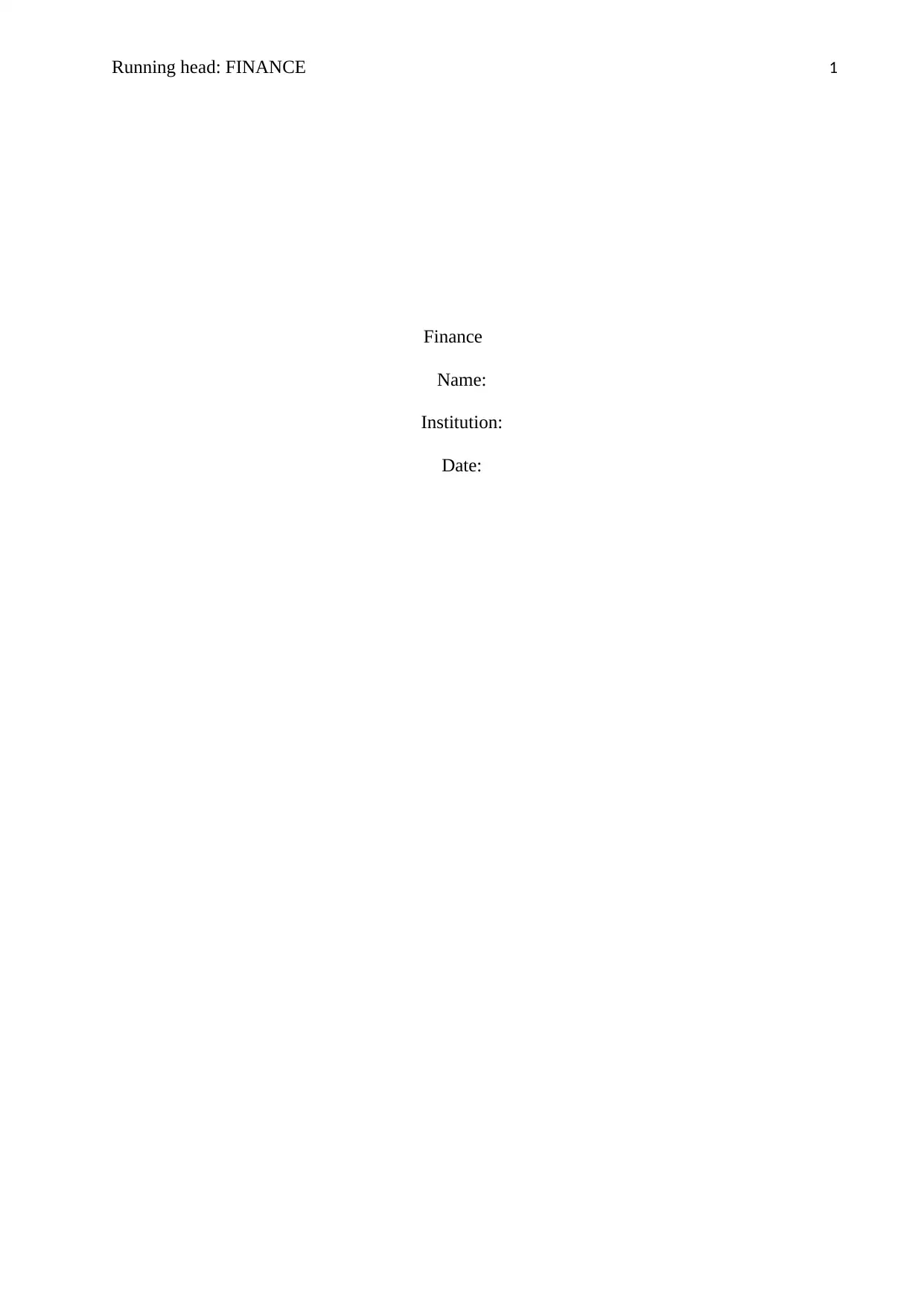
Running head: FINANCE 1
Finance
Name:
Institution:
Date:
Finance
Name:
Institution:
Date:
Paraphrase This Document
Need a fresh take? Get an instant paraphrase of this document with our AI Paraphraser
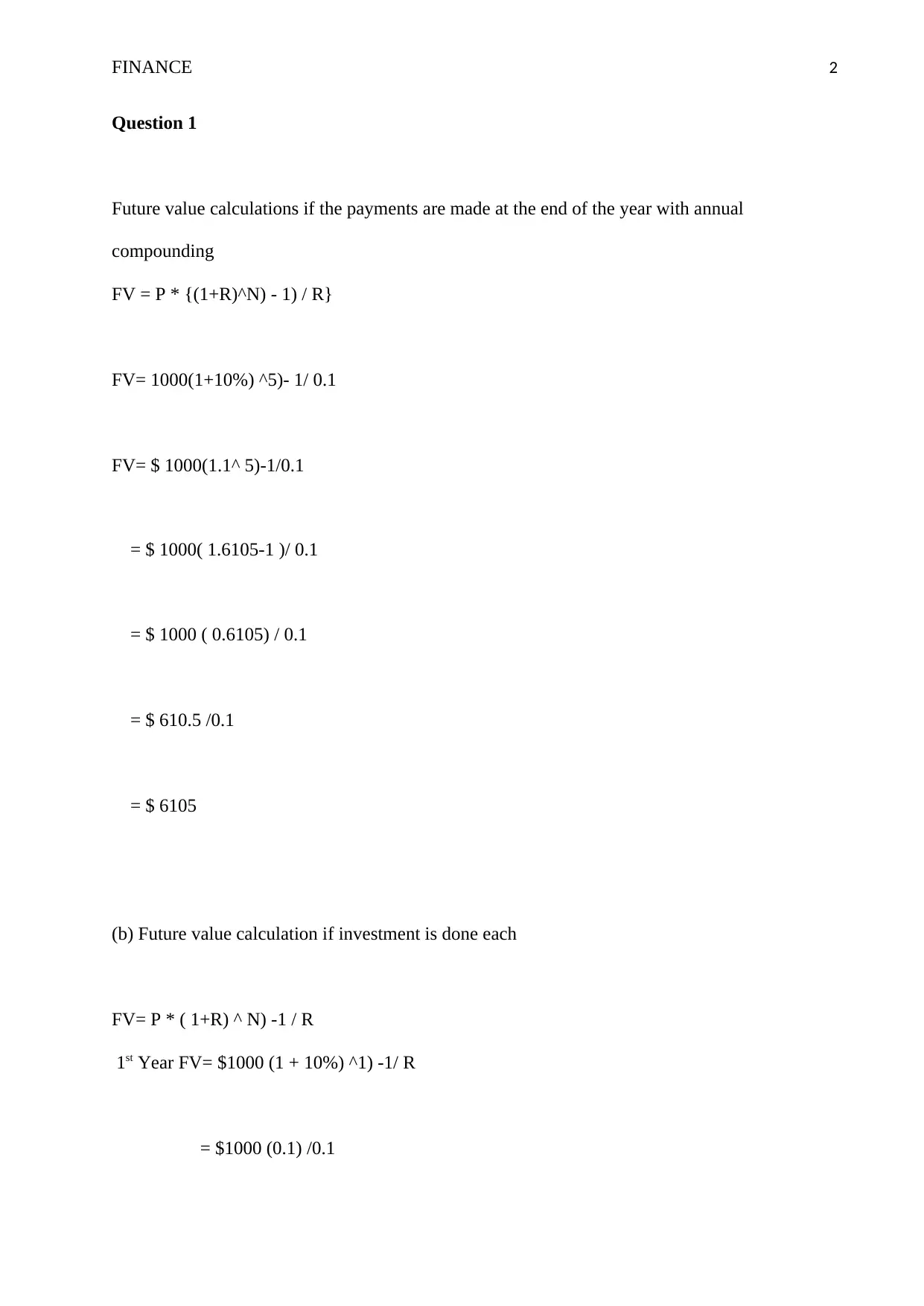
FINANCE 2
Question 1
Future value calculations if the payments are made at the end of the year with annual
compounding
FV = P * {(1+R)^N) - 1) / R}
FV= 1000(1+10%) ^5)- 1/ 0.1
FV= $ 1000(1.1^ 5)-1/0.1
= $ 1000( 1.6105-1 )/ 0.1
= $ 1000 ( 0.6105) / 0.1
= $ 610.5 /0.1
= $ 6105
(b) Future value calculation if investment is done each
FV= P * ( 1+R) ^ N) -1 / R
1st Year FV= $1000 (1 + 10%) ^1) -1/ R
= $1000 (0.1) /0.1
Question 1
Future value calculations if the payments are made at the end of the year with annual
compounding
FV = P * {(1+R)^N) - 1) / R}
FV= 1000(1+10%) ^5)- 1/ 0.1
FV= $ 1000(1.1^ 5)-1/0.1
= $ 1000( 1.6105-1 )/ 0.1
= $ 1000 ( 0.6105) / 0.1
= $ 610.5 /0.1
= $ 6105
(b) Future value calculation if investment is done each
FV= P * ( 1+R) ^ N) -1 / R
1st Year FV= $1000 (1 + 10%) ^1) -1/ R
= $1000 (0.1) /0.1
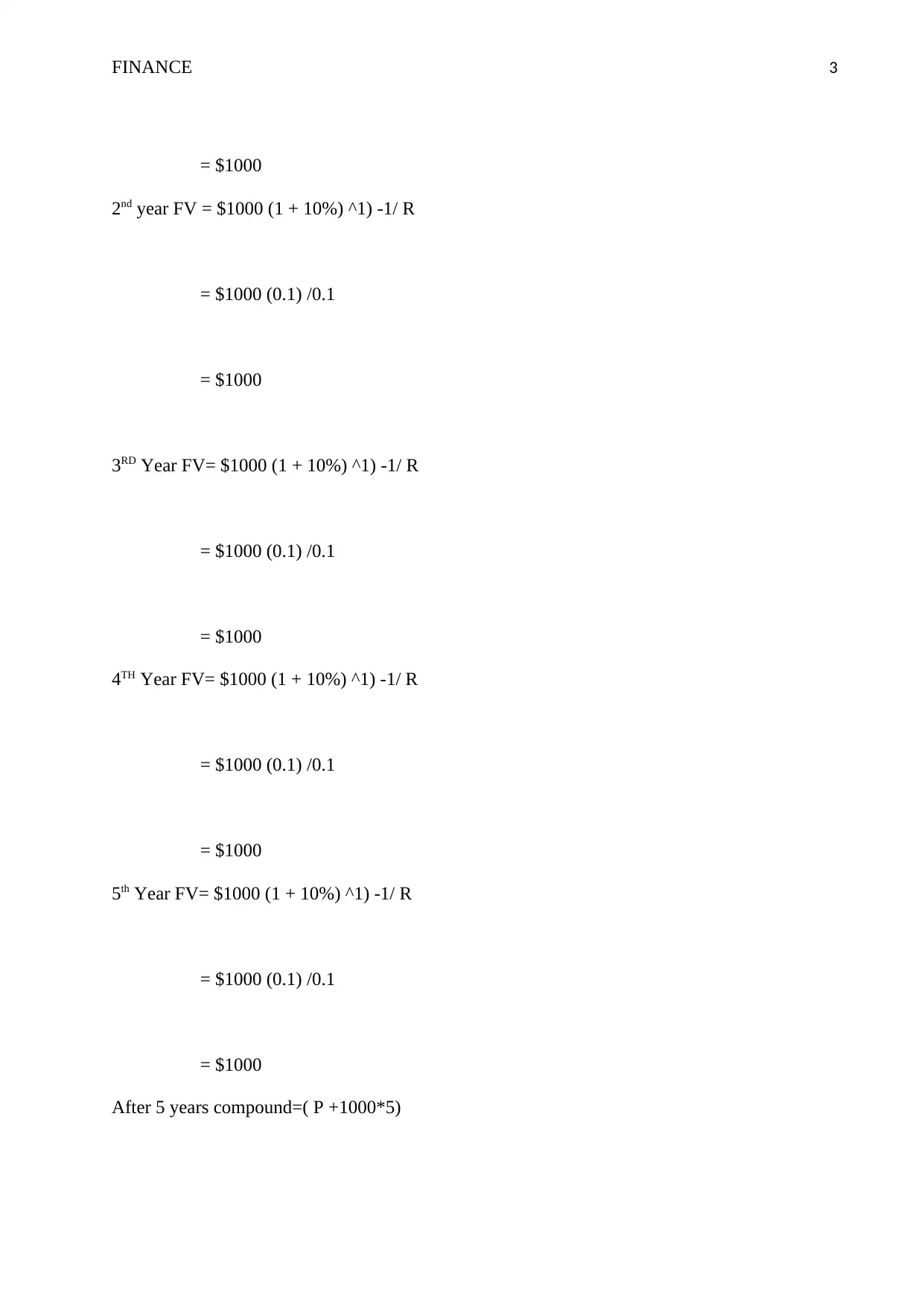
FINANCE 3
= $1000
2nd year FV = $1000 (1 + 10%) ^1) -1/ R
= $1000 (0.1) /0.1
= $1000
3RD Year FV= $1000 (1 + 10%) ^1) -1/ R
= $1000 (0.1) /0.1
= $1000
4TH Year FV= $1000 (1 + 10%) ^1) -1/ R
= $1000 (0.1) /0.1
= $1000
5th Year FV= $1000 (1 + 10%) ^1) -1/ R
= $1000 (0.1) /0.1
= $1000
After 5 years compound=( P +1000*5)
= $1000
2nd year FV = $1000 (1 + 10%) ^1) -1/ R
= $1000 (0.1) /0.1
= $1000
3RD Year FV= $1000 (1 + 10%) ^1) -1/ R
= $1000 (0.1) /0.1
= $1000
4TH Year FV= $1000 (1 + 10%) ^1) -1/ R
= $1000 (0.1) /0.1
= $1000
5th Year FV= $1000 (1 + 10%) ^1) -1/ R
= $1000 (0.1) /0.1
= $1000
After 5 years compound=( P +1000*5)
⊘ This is a preview!⊘
Do you want full access?
Subscribe today to unlock all pages.

Trusted by 1+ million students worldwide
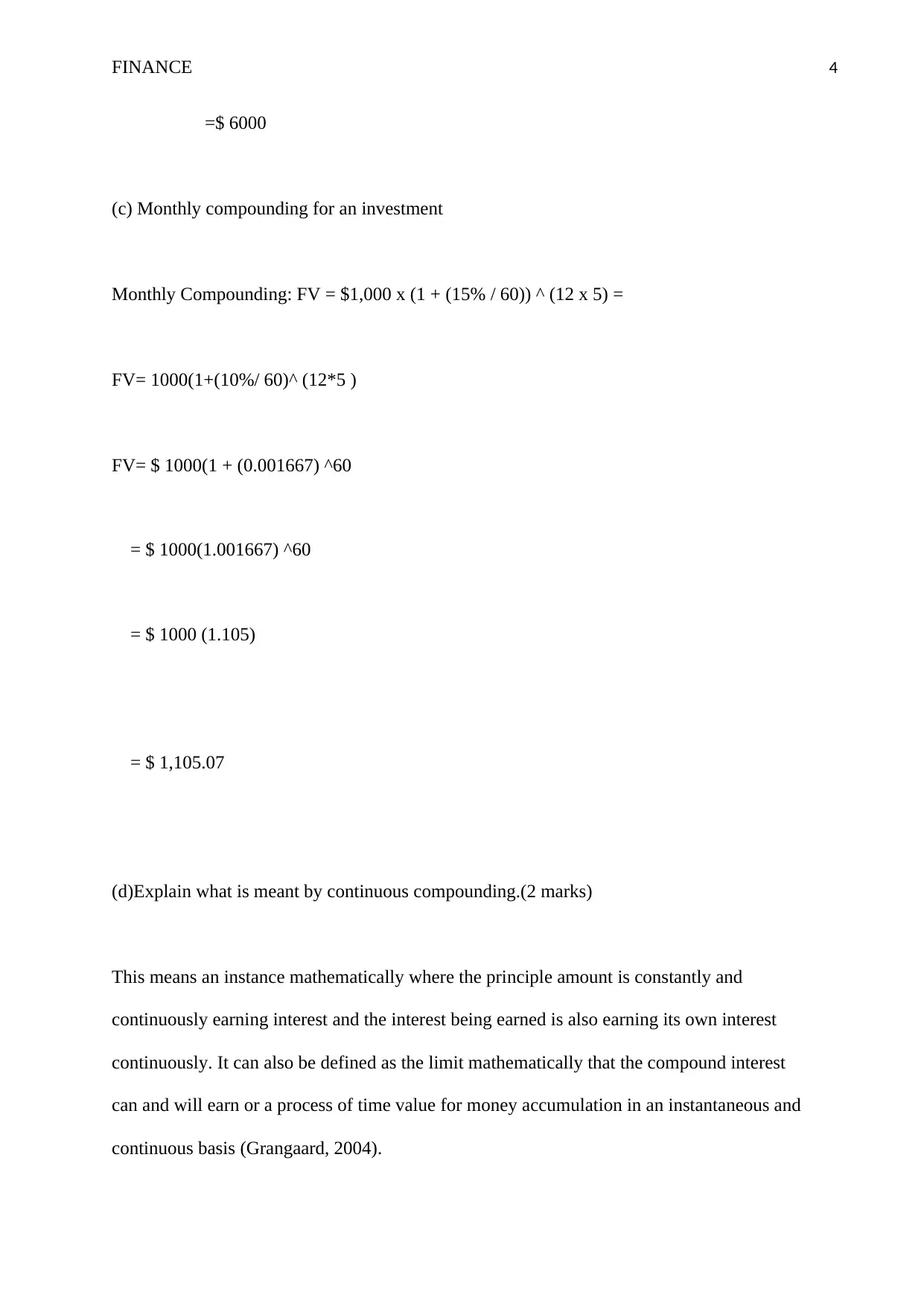
FINANCE 4
=$ 6000
(c) Monthly compounding for an investment
Monthly Compounding: FV = $1,000 x (1 + (15% / 60)) ^ (12 x 5) =
FV= 1000(1+(10%/ 60)^ (12*5 )
FV= $ 1000(1 + (0.001667) ^60
= $ 1000(1.001667) ^60
= $ 1000 (1.105)
= $ 1,105.07
(d)Explain what is meant by continuous compounding.(2 marks)
This means an instance mathematically where the principle amount is constantly and
continuously earning interest and the interest being earned is also earning its own interest
continuously. It can also be defined as the limit mathematically that the compound interest
can and will earn or a process of time value for money accumulation in an instantaneous and
continuous basis (Grangaard, 2004).
=$ 6000
(c) Monthly compounding for an investment
Monthly Compounding: FV = $1,000 x (1 + (15% / 60)) ^ (12 x 5) =
FV= 1000(1+(10%/ 60)^ (12*5 )
FV= $ 1000(1 + (0.001667) ^60
= $ 1000(1.001667) ^60
= $ 1000 (1.105)
= $ 1,105.07
(d)Explain what is meant by continuous compounding.(2 marks)
This means an instance mathematically where the principle amount is constantly and
continuously earning interest and the interest being earned is also earning its own interest
continuously. It can also be defined as the limit mathematically that the compound interest
can and will earn or a process of time value for money accumulation in an instantaneous and
continuous basis (Grangaard, 2004).
Paraphrase This Document
Need a fresh take? Get an instant paraphrase of this document with our AI Paraphraser
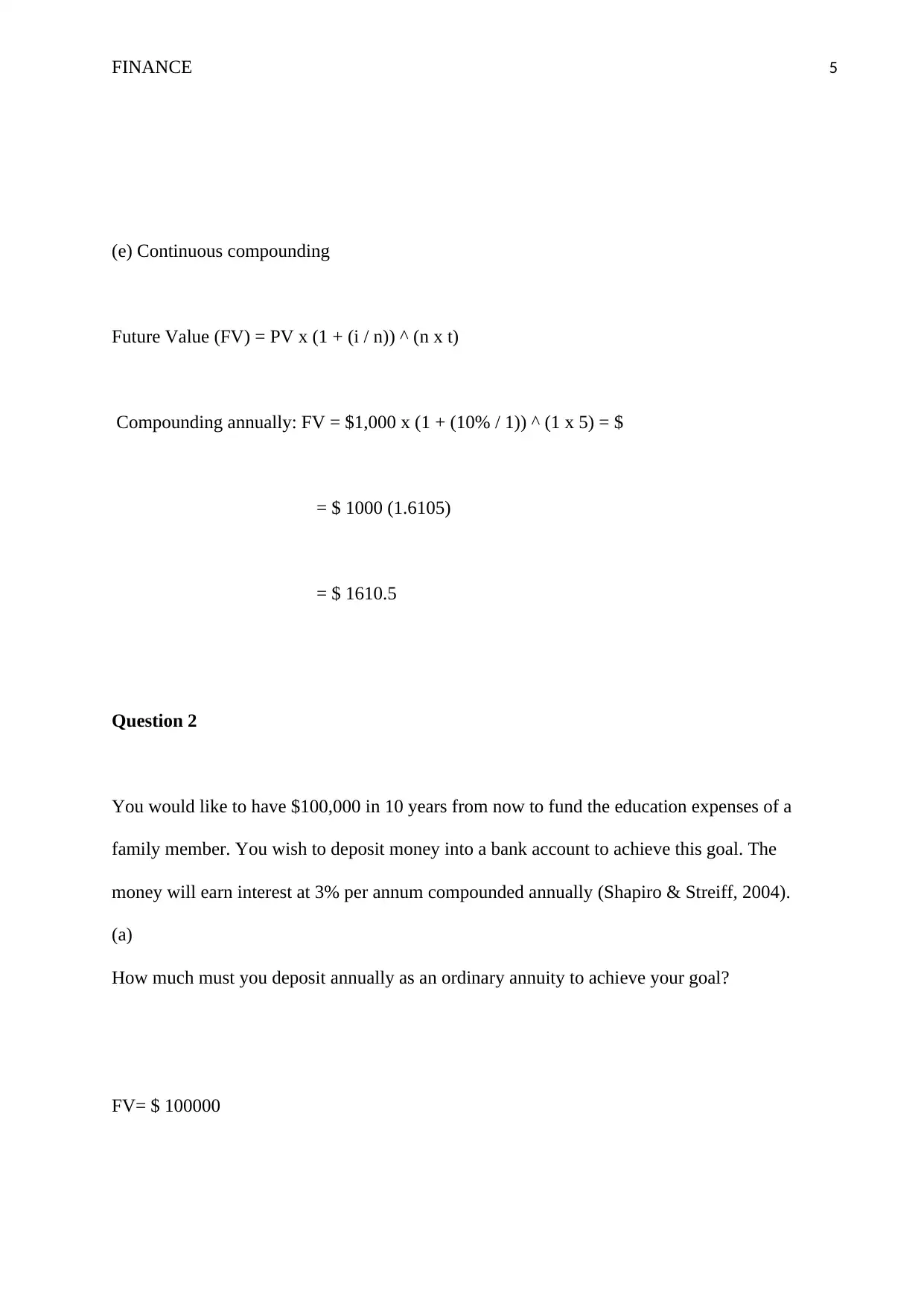
FINANCE 5
(e) Continuous compounding
Future Value (FV) = PV x (1 + (i / n)) ^ (n x t)
Compounding annually: FV = $1,000 x (1 + (10% / 1)) ^ (1 x 5) = $
= $ 1000 (1.6105)
= $ 1610.5
Question 2
You would like to have $100,000 in 10 years from now to fund the education expenses of a
family member. You wish to deposit money into a bank account to achieve this goal. The
money will earn interest at 3% per annum compounded annually (Shapiro & Streiff, 2004).
(a)
How much must you deposit annually as an ordinary annuity to achieve your goal?
FV= $ 100000
(e) Continuous compounding
Future Value (FV) = PV x (1 + (i / n)) ^ (n x t)
Compounding annually: FV = $1,000 x (1 + (10% / 1)) ^ (1 x 5) = $
= $ 1000 (1.6105)
= $ 1610.5
Question 2
You would like to have $100,000 in 10 years from now to fund the education expenses of a
family member. You wish to deposit money into a bank account to achieve this goal. The
money will earn interest at 3% per annum compounded annually (Shapiro & Streiff, 2004).
(a)
How much must you deposit annually as an ordinary annuity to achieve your goal?
FV= $ 100000
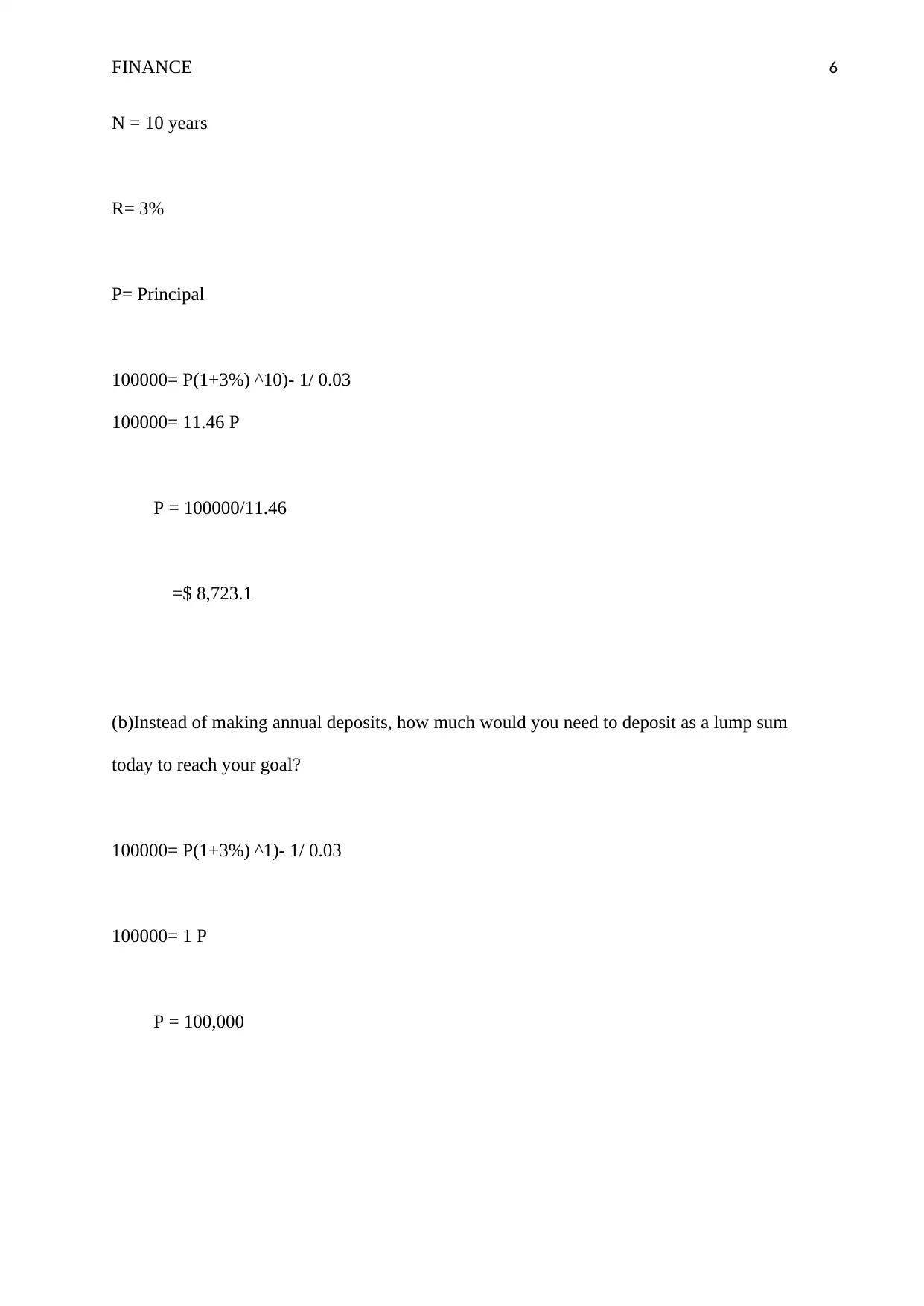
FINANCE 6
N = 10 years
R= 3%
P= Principal
100000= P(1+3%) ^10)- 1/ 0.03
100000= 11.46 P
P = 100000/11.46
=$ 8,723.1
(b)Instead of making annual deposits, how much would you need to deposit as a lump sum
today to reach your goal?
100000= P(1+3%) ^1)- 1/ 0.03
100000= 1 P
P = 100,000
N = 10 years
R= 3%
P= Principal
100000= P(1+3%) ^10)- 1/ 0.03
100000= 11.46 P
P = 100000/11.46
=$ 8,723.1
(b)Instead of making annual deposits, how much would you need to deposit as a lump sum
today to reach your goal?
100000= P(1+3%) ^1)- 1/ 0.03
100000= 1 P
P = 100,000
⊘ This is a preview!⊘
Do you want full access?
Subscribe today to unlock all pages.

Trusted by 1+ million students worldwide
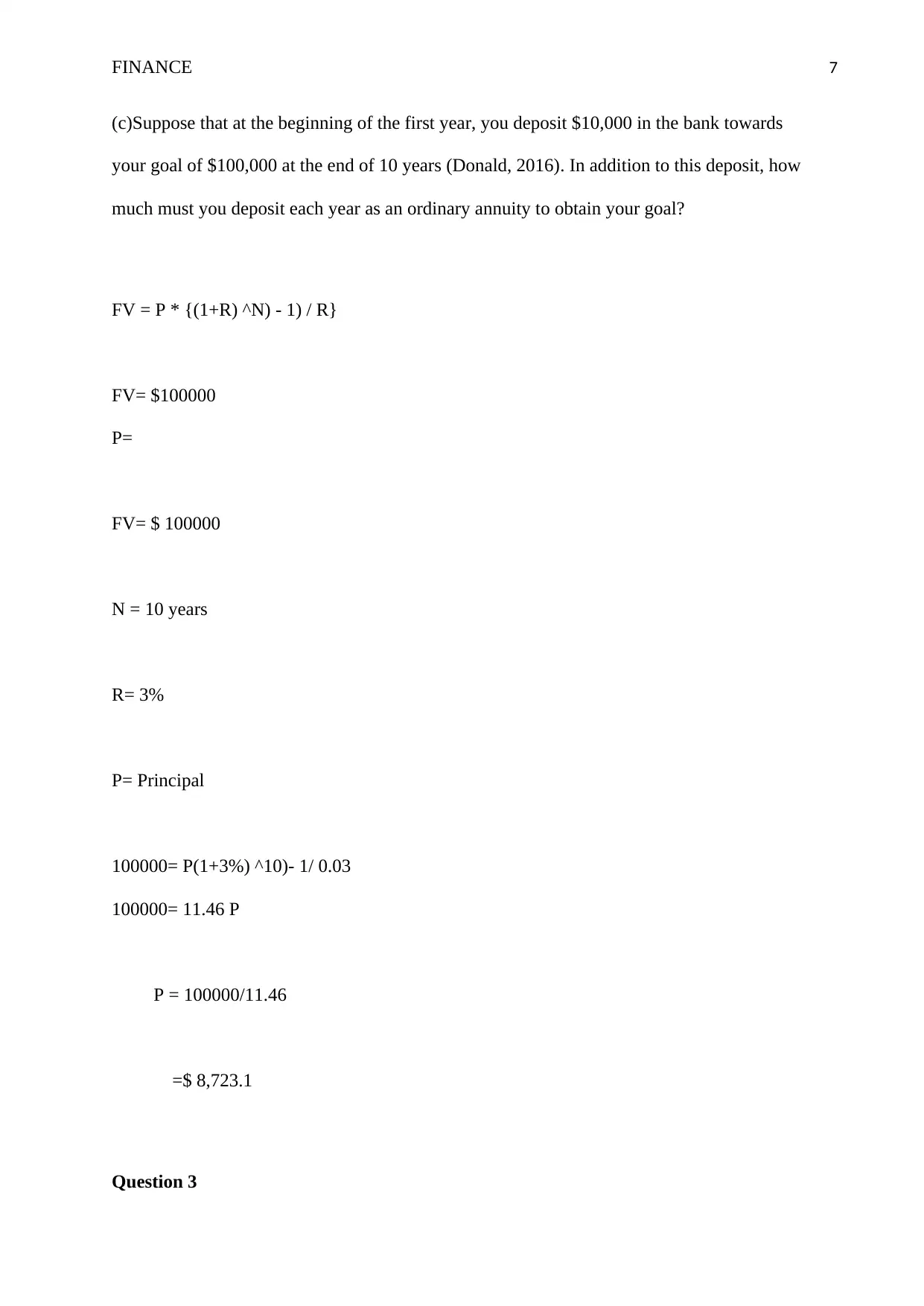
FINANCE 7
(c)Suppose that at the beginning of the first year, you deposit $10,000 in the bank towards
your goal of $100,000 at the end of 10 years (Donald, 2016). In addition to this deposit, how
much must you deposit each year as an ordinary annuity to obtain your goal?
FV = P * {(1+R) ^N) - 1) / R}
FV= $100000
P=
FV= $ 100000
N = 10 years
R= 3%
P= Principal
100000= P(1+3%) ^10)- 1/ 0.03
100000= 11.46 P
P = 100000/11.46
=$ 8,723.1
Question 3
(c)Suppose that at the beginning of the first year, you deposit $10,000 in the bank towards
your goal of $100,000 at the end of 10 years (Donald, 2016). In addition to this deposit, how
much must you deposit each year as an ordinary annuity to obtain your goal?
FV = P * {(1+R) ^N) - 1) / R}
FV= $100000
P=
FV= $ 100000
N = 10 years
R= 3%
P= Principal
100000= P(1+3%) ^10)- 1/ 0.03
100000= 11.46 P
P = 100000/11.46
=$ 8,723.1
Question 3
Paraphrase This Document
Need a fresh take? Get an instant paraphrase of this document with our AI Paraphraser
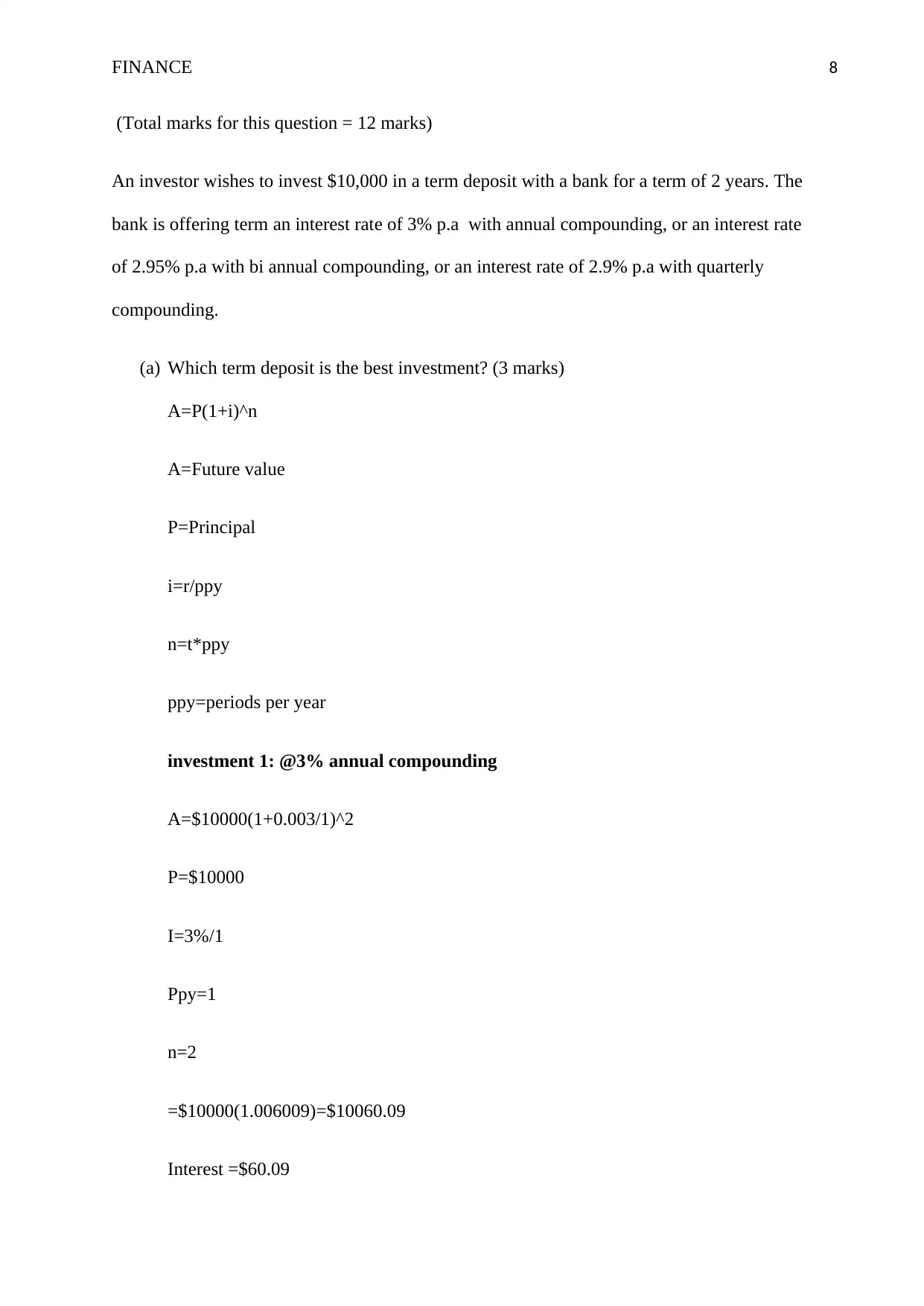
FINANCE 8
(Total marks for this question = 12 marks)
An investor wishes to invest $10,000 in a term deposit with a bank for a term of 2 years. The
bank is offering term an interest rate of 3% p.a with annual compounding, or an interest rate
of 2.95% p.a with bi annual compounding, or an interest rate of 2.9% p.a with quarterly
compounding.
(a) Which term deposit is the best investment? (3 marks)
A=P(1+i)^n
A=Future value
P=Principal
i=r/ppy
n=t*ppy
ppy=periods per year
investment 1: @3% annual compounding
A=$10000(1+0.003/1)^2
P=$10000
I=3%/1
Ppy=1
n=2
=$10000(1.006009)=$10060.09
Interest =$60.09
(Total marks for this question = 12 marks)
An investor wishes to invest $10,000 in a term deposit with a bank for a term of 2 years. The
bank is offering term an interest rate of 3% p.a with annual compounding, or an interest rate
of 2.95% p.a with bi annual compounding, or an interest rate of 2.9% p.a with quarterly
compounding.
(a) Which term deposit is the best investment? (3 marks)
A=P(1+i)^n
A=Future value
P=Principal
i=r/ppy
n=t*ppy
ppy=periods per year
investment 1: @3% annual compounding
A=$10000(1+0.003/1)^2
P=$10000
I=3%/1
Ppy=1
n=2
=$10000(1.006009)=$10060.09
Interest =$60.09
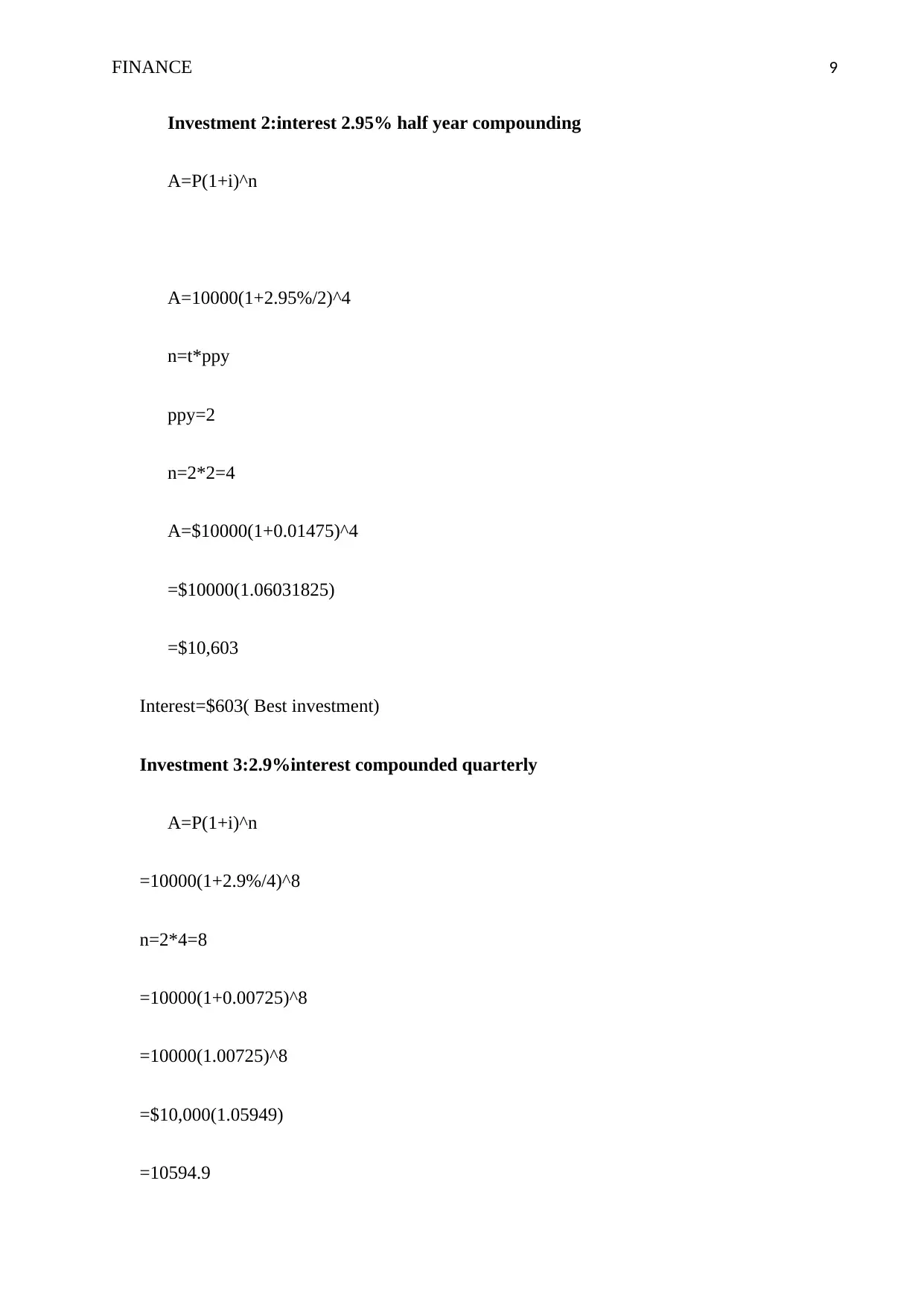
FINANCE 9
Investment 2:interest 2.95% half year compounding
A=P(1+i)^n
A=10000(1+2.95%/2)^4
n=t*ppy
ppy=2
n=2*2=4
A=$10000(1+0.01475)^4
=$10000(1.06031825)
=$10,603
Interest=$603( Best investment)
Investment 3:2.9%interest compounded quarterly
A=P(1+i)^n
=10000(1+2.9%/4)^8
n=2*4=8
=10000(1+0.00725)^8
=10000(1.00725)^8
=$10,000(1.05949)
=10594.9
Investment 2:interest 2.95% half year compounding
A=P(1+i)^n
A=10000(1+2.95%/2)^4
n=t*ppy
ppy=2
n=2*2=4
A=$10000(1+0.01475)^4
=$10000(1.06031825)
=$10,603
Interest=$603( Best investment)
Investment 3:2.9%interest compounded quarterly
A=P(1+i)^n
=10000(1+2.9%/4)^8
n=2*4=8
=10000(1+0.00725)^8
=10000(1.00725)^8
=$10,000(1.05949)
=10594.9
⊘ This is a preview!⊘
Do you want full access?
Subscribe today to unlock all pages.

Trusted by 1+ million students worldwide
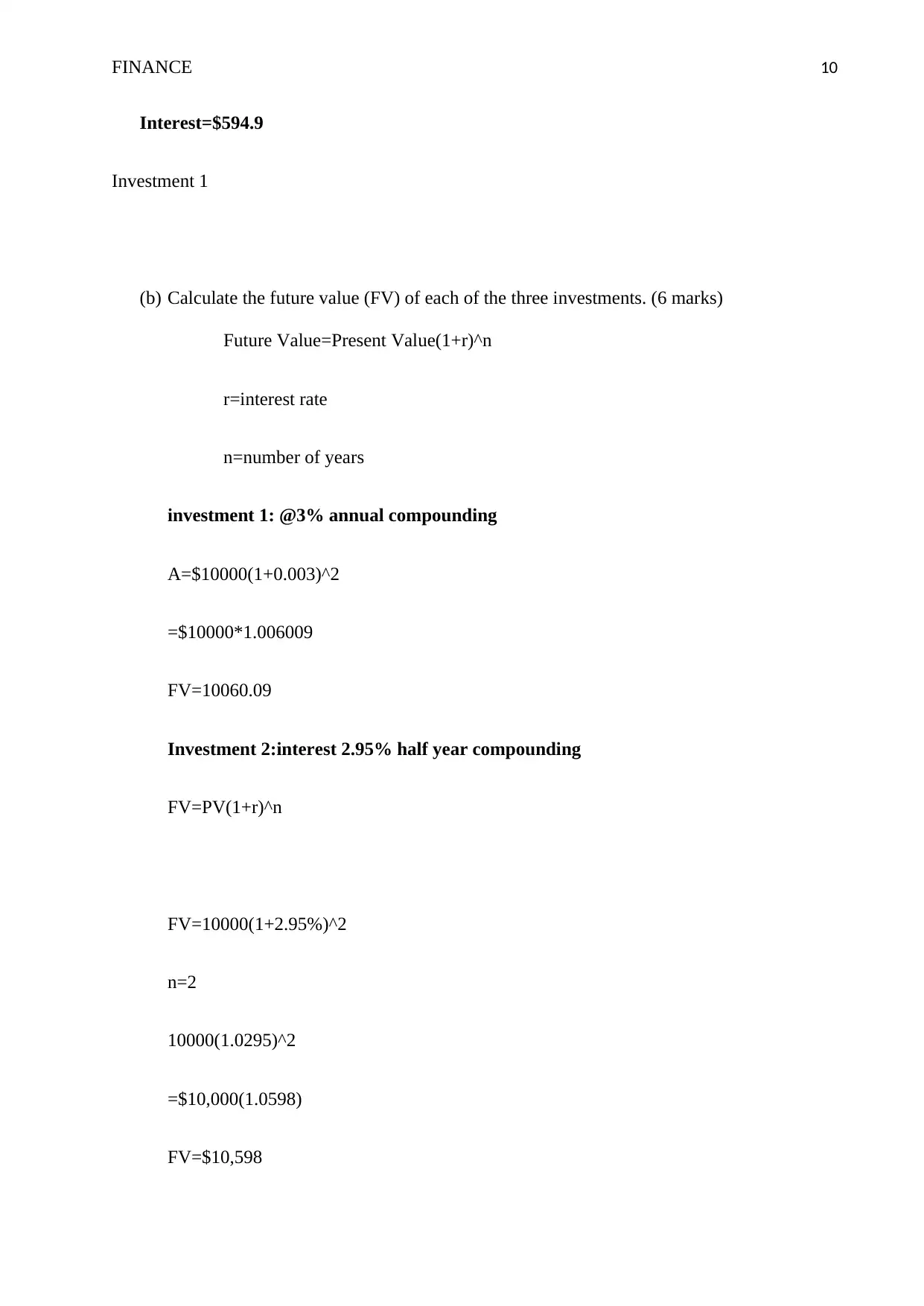
FINANCE 10
Interest=$594.9
Investment 1
(b) Calculate the future value (FV) of each of the three investments. (6 marks)
Future Value=Present Value(1+r)^n
r=interest rate
n=number of years
investment 1: @3% annual compounding
A=$10000(1+0.003)^2
=$10000*1.006009
FV=10060.09
Investment 2:interest 2.95% half year compounding
FV=PV(1+r)^n
FV=10000(1+2.95%)^2
n=2
10000(1.0295)^2
=$10,000(1.0598)
FV=$10,598
Interest=$594.9
Investment 1
(b) Calculate the future value (FV) of each of the three investments. (6 marks)
Future Value=Present Value(1+r)^n
r=interest rate
n=number of years
investment 1: @3% annual compounding
A=$10000(1+0.003)^2
=$10000*1.006009
FV=10060.09
Investment 2:interest 2.95% half year compounding
FV=PV(1+r)^n
FV=10000(1+2.95%)^2
n=2
10000(1.0295)^2
=$10,000(1.0598)
FV=$10,598
Paraphrase This Document
Need a fresh take? Get an instant paraphrase of this document with our AI Paraphraser
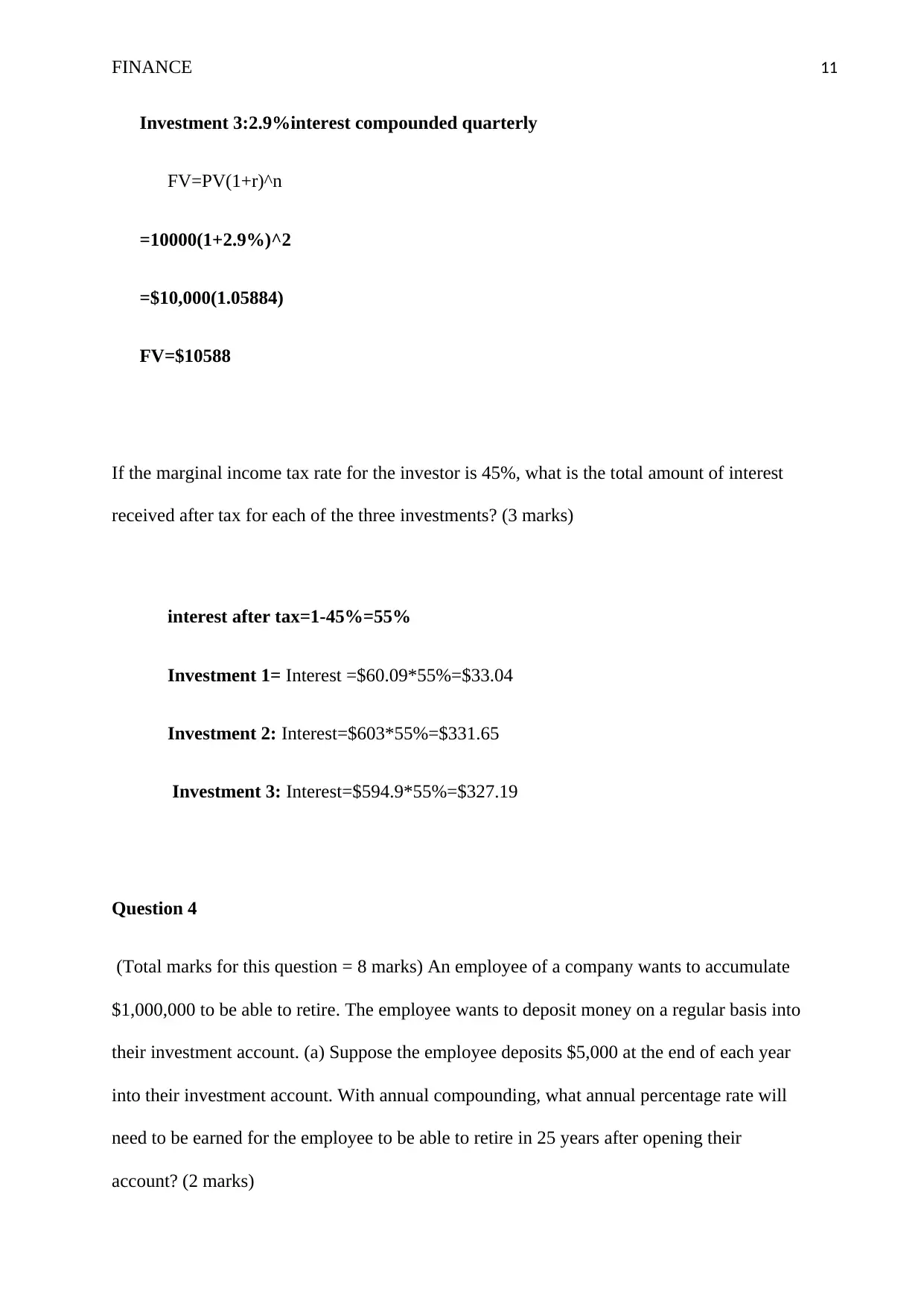
FINANCE 11
Investment 3:2.9%interest compounded quarterly
FV=PV(1+r)^n
=10000(1+2.9%)^2
=$10,000(1.05884)
FV=$10588
If the marginal income tax rate for the investor is 45%, what is the total amount of interest
received after tax for each of the three investments? (3 marks)
interest after tax=1-45%=55%
Investment 1= Interest =$60.09*55%=$33.04
Investment 2: Interest=$603*55%=$331.65
Investment 3: Interest=$594.9*55%=$327.19
Question 4
(Total marks for this question = 8 marks) An employee of a company wants to accumulate
$1,000,000 to be able to retire. The employee wants to deposit money on a regular basis into
their investment account. (a) Suppose the employee deposits $5,000 at the end of each year
into their investment account. With annual compounding, what annual percentage rate will
need to be earned for the employee to be able to retire in 25 years after opening their
account? (2 marks)
Investment 3:2.9%interest compounded quarterly
FV=PV(1+r)^n
=10000(1+2.9%)^2
=$10,000(1.05884)
FV=$10588
If the marginal income tax rate for the investor is 45%, what is the total amount of interest
received after tax for each of the three investments? (3 marks)
interest after tax=1-45%=55%
Investment 1= Interest =$60.09*55%=$33.04
Investment 2: Interest=$603*55%=$331.65
Investment 3: Interest=$594.9*55%=$327.19
Question 4
(Total marks for this question = 8 marks) An employee of a company wants to accumulate
$1,000,000 to be able to retire. The employee wants to deposit money on a regular basis into
their investment account. (a) Suppose the employee deposits $5,000 at the end of each year
into their investment account. With annual compounding, what annual percentage rate will
need to be earned for the employee to be able to retire in 25 years after opening their
account? (2 marks)
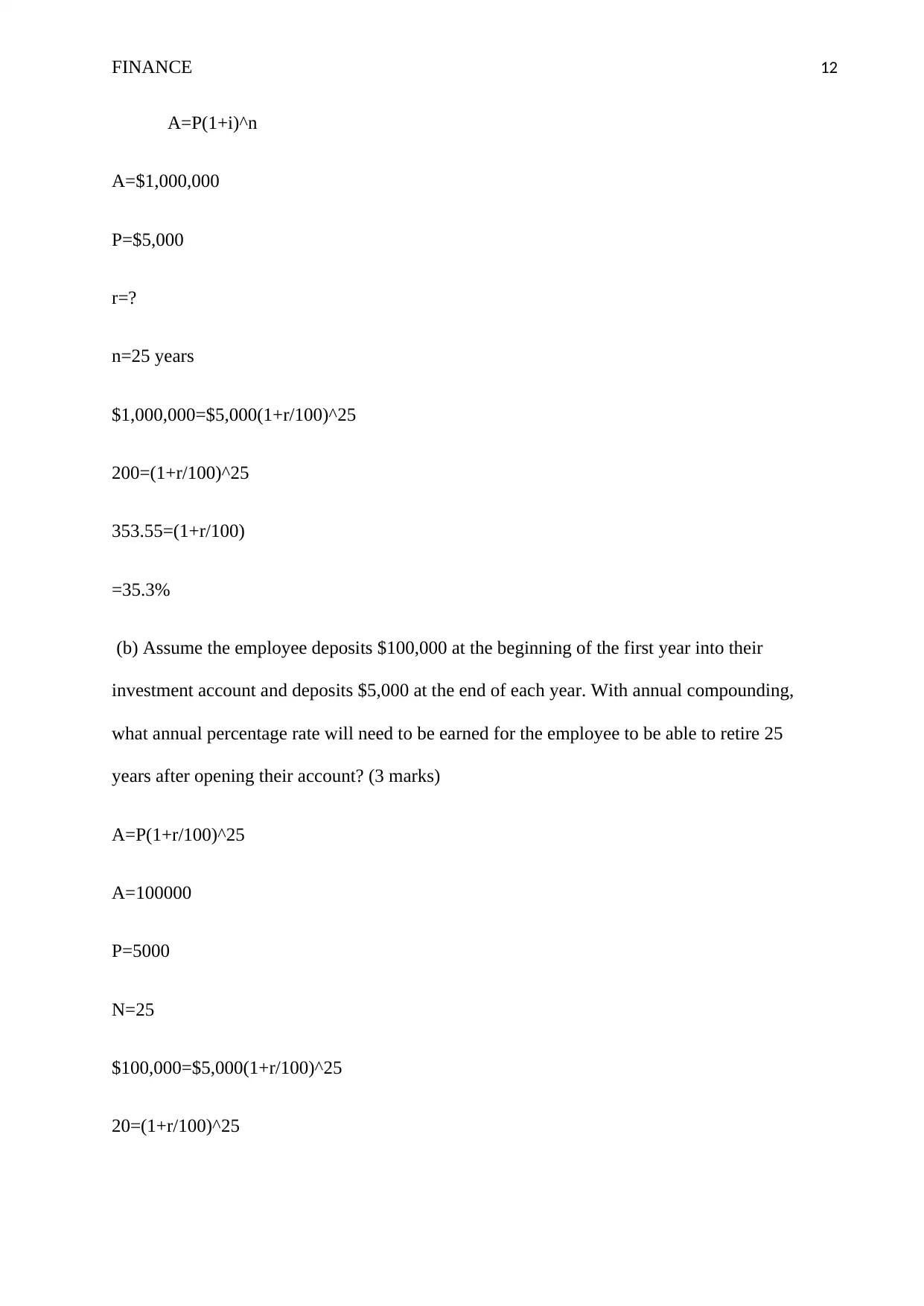
FINANCE 12
A=P(1+i)^n
A=$1,000,000
P=$5,000
r=?
n=25 years
$1,000,000=$5,000(1+r/100)^25
200=(1+r/100)^25
353.55=(1+r/100)
=35.3%
(b) Assume the employee deposits $100,000 at the beginning of the first year into their
investment account and deposits $5,000 at the end of each year. With annual compounding,
what annual percentage rate will need to be earned for the employee to be able to retire 25
years after opening their account? (3 marks)
A=P(1+r/100)^25
A=100000
P=5000
N=25
$100,000=$5,000(1+r/100)^25
20=(1+r/100)^25
A=P(1+i)^n
A=$1,000,000
P=$5,000
r=?
n=25 years
$1,000,000=$5,000(1+r/100)^25
200=(1+r/100)^25
353.55=(1+r/100)
=35.3%
(b) Assume the employee deposits $100,000 at the beginning of the first year into their
investment account and deposits $5,000 at the end of each year. With annual compounding,
what annual percentage rate will need to be earned for the employee to be able to retire 25
years after opening their account? (3 marks)
A=P(1+r/100)^25
A=100000
P=5000
N=25
$100,000=$5,000(1+r/100)^25
20=(1+r/100)^25
⊘ This is a preview!⊘
Do you want full access?
Subscribe today to unlock all pages.

Trusted by 1+ million students worldwide
1 out of 14
Related Documents
Your All-in-One AI-Powered Toolkit for Academic Success.
+13062052269
info@desklib.com
Available 24*7 on WhatsApp / Email
![[object Object]](/_next/static/media/star-bottom.7253800d.svg)
Unlock your academic potential
Copyright © 2020–2025 A2Z Services. All Rights Reserved. Developed and managed by ZUCOL.




